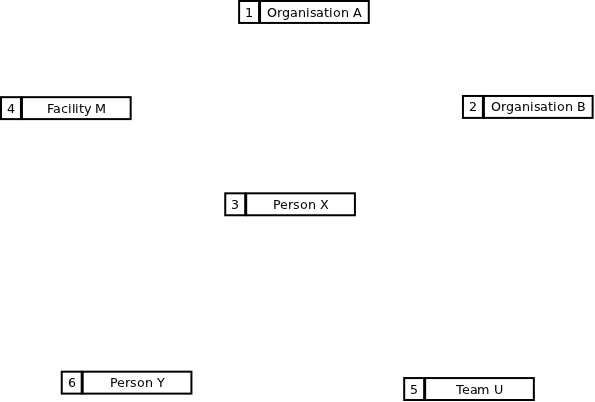| Version 6 (modified by , 13 years ago) ( diff ) |
|---|
Table of Contents
Person Entity Model
The Person Entity Model defines a framework for the modelling of person-related entities like organisations, teams and other groups - and of course persons. It includes a generic model for affiliation, which shall be introduced here.
Introduction
We start with an obviously simple (read: small) set of person entities:
Roles
Each of these entities can define a number of roles by which other entities can be affiliated with them:
Affiliation
If we link the affiliated entities to these roles, then we get an already pretty complex network of relationships:
Hierarchy
Some affiliations define a hierarchy (in the sense of "reporting units" or "organisational units"), while others don't:
Ancestor Paths
To analyze this hierarchy, we look at the ancestor paths from one entity to another entity:
It becomes a little bit more obvious if we remove the roles from the diagram:
These paths can easily be expressed as tuples of IDs, e.g. for Person Y we have two paths (4,1) and (5,2), and for Person X we have (5,2) and (2). Apparently, Person Y is affiliated with two different organisations here.
Hierarchy Levels
To make the actual "hierarchy" visible, we need to move each entity to a particular "hierarchy level":
Due to the heterogenous nature of this network, the "hierarchy" is not universal, but rather limited to each path - i.e. it is not universally definable whether a "team" ranks higher in the hierarchy than a "facility" - or vice versa. But within each path it becomes explicit.
Attachments (7)
- pe_hierarchy1.png (9.8 KB ) - added by 13 years ago.
- pe_hierarchy2.png (22.6 KB ) - added by 13 years ago.
- pe_hierarchy3.png (36.0 KB ) - added by 13 years ago.
- pe_hierarchy4.png (37.4 KB ) - added by 13 years ago.
- pe_hierarchy5.png (45.4 KB ) - added by 13 years ago.
- pe_hierarchy6.png (23.9 KB ) - added by 13 years ago.
- pe_hierarchy7.png (17.2 KB ) - added by 13 years ago.
Download all attachments as: .zip








